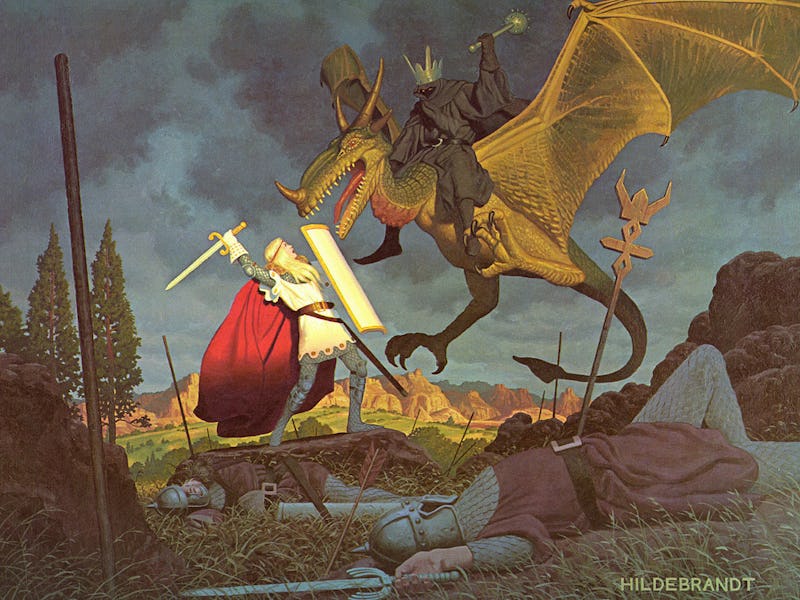Tolkien's Myth-Building Masterpiece 'Return of the King' Turns 60
Fairy tale logic to rule us all.

When, on October 20, 1955, the final installment of J. R. R. Tolkien’s Lord of the Rings series hit shelves in the United Kingdom, the high fantasy genre wasn’t forever altered so much as it was distilled. Tolkien’s Return of the King was a celebration of world-building and language was the man’s party hat — one gets the sense that, had his publishers allowed, Tolkien would have churned out the whole thing in Elvish. That the author spared no attention when it came to Middle-earth’s minutiae is often celebrated as the reason the Lord of the Rings ticks, but we can hone that thesis further: It’s Tolkien’s understanding of how details build myths that sets his work apart.
Near the beginning of Return of the King, Pippin and Gandalf approach Minas Tirith. Here, Tolkien pauses for a moment to lay out the magnificent fortress city. If you’re constructing a set-piece for a great fantasy battle down the line, look to the OG fantasy dude for inspiration:
For the fashion of Minas Tirith was such that it was built on seven levels, each delved into the hill, and about each was set a wall, and in each wall was a gate. But the gates were not set in a line: the Great Gate in the City Wall was at the east point of the circuit, but the next faced half south, and the third half north, and so to and fro upwards; so that the paved way that climbed towards the Citadel turned first this way and then that across the face of the hill. And each time that it passed the line of the Great Gate it went through an arched tunnel, piercing a vast pier of rock whose huge out-thrust bulk divided in two all the circles of the City save the first. For partly in the primeval shaping of the hill, partly by the mighty craft and labour of old, there stood up from the rear of the wide court behind the Gate a towering bastion of stone, its edge sharp as a ship-keel facing east. Up it rose, even to the level of the topmost circle, and there was crowned by a battlement; so that those in the Citadel might, like mariners in a mountainous ship, look from its peak sheer down upon the Gate seven hundred feet below. The entrance to the Citadel also looked eastward, but was delved in the heart of the rock; thence a long lamp-lit slope ran up to the seventh gate. Thus men reached at last the High Court, and the Place of the Fountain before the feet of the White Tower: tall and shapely, fifty fathoms from its base to the pinnacle, where the banner of the Stewards floated a thousand feet above the plain.
This is myth-building scraped out of world-building: Is the huge outcropping of stone that faces a horseshoe of Mordor mountains geologically sound? What sort of economy would support the labor of something so ludicrous as Minas Tirith? But pause for a moment, and listen: What you hear is the sound of the banner of Stewards flapping in the wind, high above the plain, drowning out something as trifling as logistics in a crack of high fantasy badassery. What Tolkien needs is a set-up for the greatest battle between Good and Evil the world has ever known. The details matter, but they aren’t the most important thing.
It’s an eye for the flags and gates and outcroppings that, as improbable as though they may be, make Middle-earth feels alive and worthy of emotional investment. Because of course the architect of Minas Tirith is a smart fellow, and would reason out that you’re not going to want the gates to face each other directly, to force any sort of enemy to double back, giving defenses more time to respond. Though the details defy reason, Tolkien’s story is a hell of a lot sexier.
Myth logic endures. Stephen King’s Dark Tower series was born out, in part, by King’s dreams of hobbit epics. There is nothing resembling logistics to support a tapestry of werewolves, gunfighters, and weaponized golden snitches; and yet this monstrous universe does not collapse in on itself thanks to myth logic that fizzes and hums. What King and Tolkien understand is that myth logic works best in glimpses.
And Tolkien’s Lord of the Rings lessons will echo again in December, when myth — a giant hulk of a Star Destroyer — meets the logic of a scrappy junk collector eking out a living in a desert. The lived-in fantasy realm, not the language of the orcs, was Tolkien’s greatest invention. He taught us to enjoy disbelief rather than suspend it.